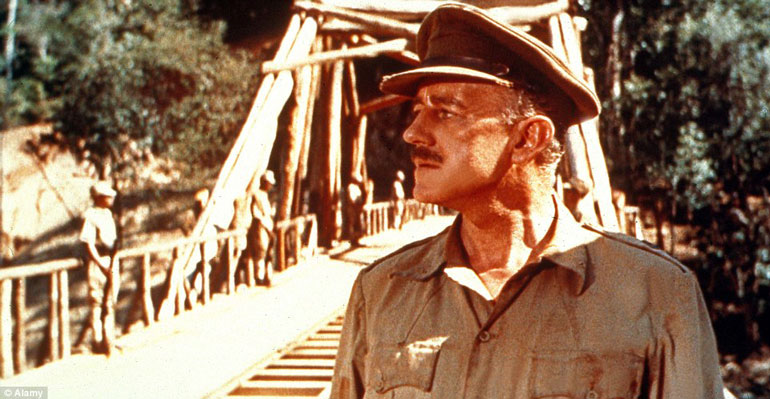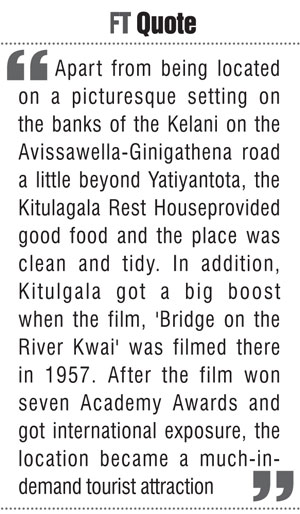Thursday Dec 18, 2025
Thursday Dec 18, 2025
Saturday, 27 February 2016 00:00 - - {{hitsCtrl.values.hits}}

 By D.C. Ranatunga
By D.C. Ranatunga
It was the era when hotels were rare in the outstations. Instead of hotels there were Rest-Houses which were managed by local bodies. A Rest-House Keeper was in charge.
I remember one at Hanwella (where I grew up) on the Colombo-Avissawella road just 18 miles from Colombo. It was at the highest point in the town on the bank of the Kelani Ganga and was one place which was never affected by floods when the whole area went under water every year in May.
The recent news item that at Kitulgala there are protests about a proposal to meddle with the water flow of the river reminded me that the Kitulagala Rest House has been one of the most popular rest houses for several decades.
Apart from being located on a picturesque setting on the banks of the Kelani on the Avissawella-Ginigathena road a little beyond  Yatiyantota, it provided good food and the place was clean and tidy. In addition, Kitulgala got a big boost when the film, ‘Bridge on the River Kwai’ was filmed there in 1957. After the film won seven Academy Awards and got international exposure, the location became a much-in-demand tourist attraction.
Yatiyantota, it provided good food and the place was clean and tidy. In addition, Kitulgala got a big boost when the film, ‘Bridge on the River Kwai’ was filmed there in 1957. After the film won seven Academy Awards and got international exposure, the location became a much-in-demand tourist attraction.
For the villagers in and around the place, it was an unexpected bonus. Showing the tourists the way to the famous site where the film was shot and dramatizing how the bridge was built and how it was blown up gave them a few extra rupees. In recent years it became a popular venue for water rafting.
During the rest-house era while some were maintained quite well, most of them were below par. Apart from Kitulgala RH, among the better ones where I have stayed and found the service pretty good were several others.
Belihul Oya RH beyond Balangoda located by a stream coming down from Horton Plains; Ella RH on the Badulla – Wellawaya road where the view from the rest-house down the precipice over miles of distant jungle was superb; Kantalai RH where I had read about a haunting ghost supposed to be a holidaying planter who was killed by the sudden fall of a stone corbel from the wall (I was not troubled) and Polonnaruwa RH which got a massive facelift when Queen Elizabeth II and Price Philip had to spend a night during their 1954 tour, to name a few.
Though, as the name suggests, rest-houses were meant to be places where one could rest after a day of either sight-seeing or attending to some work in the area, many did not provide satisfactory facilities to rest.
I remember while on a field tour after joining the Tobacco Company in the early 1970s, a colleague and I had a not-so-happy stay at Hanguranketa RH. We were quite tired having walked through tobacco plantations and were waiting to have a bath and relax. As we walked into bathroom, we were greeted by a couple of lizards who seemed to be permanent residents! By late evening the place was virtually a tavern with the tobacco growers who had obviously sold their crop that day had come to ‘celebrate’.
Going on a long trip in the late 1950s, we spent a night at the Haputale rest house. There was heavy rain that night accompanied by gushing winds. The ‘takaran’ roof started to shake with the tin sheets virtually being blown off. The cold was severe but we weren’t prepared for it. I remember sneezing the whole night and getting scolded by the friends for disturbing their sleep!
Tourist promotion
Judging from an advertisement I picked up from the ‘Ceylon Observer Pictorial 1938’, The Government Tourist Bureau was promoting  rest-houses which obviously in their opinion provided a good service.
rest-houses which obviously in their opinion provided a good service.
Featuring four rest-houses – Negombo, Ambalangoda, Hanwella and Kaduwela – all easily accessible from Colombo, the advertisement had a quote from ‘Fountains in the sand’ (1912) written by Norman Douglas described as a scholar and connoisseur: ‘How often have I yearned for the material comfort and the decent fare of a rest house in the jungle of Ceylon’.
Apart from the Tourist Bureau – Colombo, particulars could be obtained from Ceylon House – Aldwych-London, Ceylon House – Hornby Rd-Bombay and shipping companies and travel agencies, the advertisement said. That was tourist promotion 80 years ago!
Today the Ceylon Hotels Corporation is managing selected rest-houses in several parts of the country.
The film
Going back to ‘Bridge on the River Kwai’ – considered one of the most iconic movies of all time – the film was based on the treatment of prisoners of war during the World War II.
Set in the Japanese-held Burma (now Myanmar), it relates the story of how the senior British officer, Lieutenant Colonel Nicholsan (played superbly by Alec Guinness who won the Academy Award for Best Actor) resisted the orders of the Japanese commandant, Colonel Saito (Sessue Hayakawa) that all prisoners irrespective of their rank should constrict a bridge over the River Kwai to connect Bangkok and Rangoon. He disregards Colonel Nicolson’s protest that the Geneva Conventions exempt officers from manual labour.
The theme music of the film, ‘Colonel Bogey March’ played by the Philharmonic Orchestra, became a hit and is popular even today.
At the Academy Awards 1958, the film won awards for Best Picture (Sam Spiegel), Best Director (David Lean), Best Actor, Best Writing/Screenplay, Best Music (Malcolm Arnold), Best Editing (Peter Taylor) and Best Cinematography (Jack Hildyard). Hayakawa was nominated for Best Actor in a Supporting Role. The film won 12 more awards in five other international Awards presentations and was selected for preservation in the United States National Film Registry.
Rest-houses – originally Dutch institutions intended as the headquarters of a revenue district and affording shelter for visiting officials – were developed by the British into wayside inns for travellers of all sorts.
In the ‘planting’ districts they did duty as a sort of Country Club – and are maintained by various State or State-controlled authorities still more or less in the public interest. They vary from very comfortable to not-so-restful and ill-equipped, but nearly all share a common distinction: they are generally excellently sited.
– ‘Thanayama’ in the ‘Handbook for the Ceylon Traveller’ (1974)